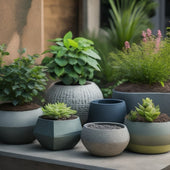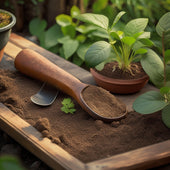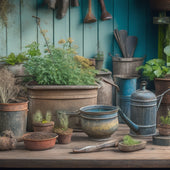
3 Urban Gardening Blunders to Steer Clear Of
Share
When it comes to urban gardening, you'll want to avoid three common blunders that can sabotage your efforts. First, don't ignore local climate conditions - temperature, moisture, and sunlight patterns can make or break your garden's success. Next, neglecting soil quality control can lead to plant failure, so make certain to test and adjust your soil's pH level and nutrient balance. Finally, insufficient light management can leave your plants struggling, so choose varieties that fit your garden's lighting conditions and adjust as needed. By sidestepping these mistakes, you'll be well on your way to growing a thriving urban garden, and there's more to learn to guarantee your success.
Key Takeaways
• Ignoring local climate conditions leads to poor plant selection and seasonal timing, resulting in weak plants vulnerable to pests and diseases.
• Failing to conduct soil tests and adjust soil conditions can cause plant failure due to poor soil quality and inadequate nutrient balance.
• Inadequate light management can hinder plant growth, so it's essential to consider each plant species' unique lighting requirements.
• Drought-tolerant plants are ideal for hot climates, while frost-resistant plants thrive in cooler areas, making informed plant selection crucial.
• Regular monitoring and adjustment of plant placement ensure adequate light access and prevent disappointment in urban gardens.
Ignoring Local Climate Conditions
Overlooking the specific temperature, moisture, and sunlight patterns in your area can lead to a garden that's doomed from the start, wasting your time, money, and effort.
You might think you're saving time by skipping this step, but trust us, it's essential. Understanding your local climate conditions is fundamental for making informed decisions about plant selection and seasonal timing.
When it comes to plant selection, you need to choose plants that thrive in your specific climate. If you live in an area with hot summers, you'll want to opt for drought-tolerant plants. In cooler climates, you'll need plants that can withstand frost.
Don't assume that just because a plant looks pretty, it'll do well in your garden. Do your research and choose plants that are compatible with your local conditions.
Seasonal timing is also critical. Knowing when to plant, prune, and harvest is crucial for a successful garden. Planting at the wrong time can lead to weak, struggling plants that are more susceptible to pests and diseases.
Inadequate Soil Quality Control
You'll be shocked at how quickly poor soil quality can turn your urban garden into a barren wasteland, sucking the life out of your plants and leaving you frustrated and defeated.
Don't let this happen to you! Inadequate soil quality control is a common blunder that can be easily avoided with a little planning and effort.
The first step is to test your soil to determine its pH level and nutrient balance. This will give you a clear picture of what your soil lacks and what it needs to support healthy plant growth.
Based on the test results, you can adjust your soil's pH level and nutrient balance by adding organic matter, fertilizers, or other amendments.
Remember, a balanced soil is key to a thriving garden. Without it, your plants will struggle to survive, let alone thrive.
Insufficient Light Management
When it comes to giving your plants the light they need, it's essential to take into account the unique lighting requirements of each species and create a layout that maximizes sunlight exposure in your urban garden. You'll want to take into account the direction your garden receives sunlight and adjust your plant placement accordingly.
For instance, if you have plants that require full sun, you'll want to place them in areas that receive direct sunlight for at least 6 hours a day. On the other hand, plants that prefer partial shade should be placed in areas with filtered or dappled light.
Here are some additional tips to keep in mind:
-
Choose plants wisely: Select plants that are suitable for your garden's lighting conditions to avoid disappointment.
-
Optimize light placement: Think about using mirrors or reflective surfaces to bounce light onto plants that need more illumination.
-
Monitor and adjust: Keep an eye on your plants' response to light and adjust their placement as needed to make sure they're getting the light they need to thrive.
Frequently Asked Questions
How Often Should I Water My Urban Garden in Dry Weather?
When dry weather hits, you'll need a solid watering schedule to keep your urban garden thriving. Aim to water deeply 2-3 times a week, and follow these drought tips: mulch, use drip irrigation, and water in the early morning or evening to minimize evaporation.
What Are Some Natural Pest Control Methods for Urban Gardens?
You're on high alert, watching pests devour your precious harvest, but fear not! You can outsmart them with companion planting, attracting beneficial insects like ladybugs and lacewings to do the dirty work for you.
Can I Grow Vegetables in a Garden With Mostly Shade?
You can grow veggies in a shaded garden, but most need at least partial sun. Check the light requirements for each type, and choose shade-tolerant varieties like lettuce, spinach, or herbs that thrive in low-light conditions.
How Do I Prevent Weeds From Taking Over My Urban Garden?
"Are you tired of weeds stealing the show in your garden? You prevent them from taking over by applying a thick layer of mulch, which suppresses weed growth and retains moisture, letting your veggies thrive."
What Is the Ideal Garden Size for a Small Urban Balcony?
When designing your urban balcony garden, you'll want to contemplate a layout that maximizes space, choosing containers that are proportionate to your balcony's dimensions, ensuring a harmonious and thriving oasis, no matter how small.
Related Posts
-

5 Best DIY Planter Ideas to Upcycle Concrete
You're about to breathe new life into discarded concrete blocks by transforming them into functional and visually app...
-

5 Best DIY Planter Ideas to Upcycle Concrete
You're about to breathe new life into discarded concrete blocks by transforming them into functional and visually app...
-

5 Best DIY Planter Ideas to Upcycle Concrete
You're about to breathe new life into discarded concrete blocks by transforming them into functional and visually app...
-

5 Best DIY Planter Ideas to Upcycle Concrete
You're about to breathe new life into discarded concrete blocks by transforming them into functional and visually app...
-

5 Best DIY Planter Ideas to Upcycle Concrete
You're about to breathe new life into discarded concrete blocks by transforming them into functional and visually app...
-

5 Best DIY Planter Ideas to Upcycle Concrete
You're about to breathe new life into discarded concrete blocks by transforming them into functional and visually app...
-

5 Best DIY Planter Ideas to Upcycle Concrete
You're about to breathe new life into discarded concrete blocks by transforming them into functional and visually app...
-

5 Best DIY Planter Ideas to Upcycle Concrete
You're about to breathe new life into discarded concrete blocks by transforming them into functional and visually app...
-

5 Best DIY Planter Ideas to Upcycle Concrete
You're about to breathe new life into discarded concrete blocks by transforming them into functional and visually app...
-

5 Best DIY Planter Ideas to Upcycle Concrete
You're about to breathe new life into discarded concrete blocks by transforming them into functional and visually app...
-

5 Best DIY Planter Ideas to Upcycle Concrete
You're about to breathe new life into discarded concrete blocks by transforming them into functional and visually app...
-

5 Best DIY Planter Ideas to Upcycle Concrete
You're about to breathe new life into discarded concrete blocks by transforming them into functional and visually app...
-

5 Best DIY Planter Ideas to Upcycle Concrete
You're about to breathe new life into discarded concrete blocks by transforming them into functional and visually app...
-

5 Best DIY Planter Ideas to Upcycle Concrete
You're about to breathe new life into discarded concrete blocks by transforming them into functional and visually app...
-

5 Best DIY Planter Ideas to Upcycle Concrete
You're about to breathe new life into discarded concrete blocks by transforming them into functional and visually app...
-

5 Best DIY Planter Ideas to Upcycle Concrete
You're about to breathe new life into discarded concrete blocks by transforming them into functional and visually app...
-

5 Best DIY Planter Ideas to Upcycle Concrete
You're about to breathe new life into discarded concrete blocks by transforming them into functional and visually app...
-

5 Best DIY Planter Ideas to Upcycle Concrete
You're about to breathe new life into discarded concrete blocks by transforming them into functional and visually app...
-

What Makes a Good Used Trowel for Planters
When searching for a good used trowel for planters, you'll want to prioritize corrosion-resistant materials like stai...
-

What Makes a Good Used Trowel for Planters
When searching for a good used trowel for planters, you'll want to prioritize corrosion-resistant materials like stai...
-

What Makes a Good Used Trowel for Planters
When searching for a good used trowel for planters, you'll want to prioritize corrosion-resistant materials like stai...
-

What Makes a Good Used Trowel for Planters
When searching for a good used trowel for planters, you'll want to prioritize corrosion-resistant materials like stai...
-

What Makes a Good Used Trowel for Planters
When searching for a good used trowel for planters, you'll want to prioritize corrosion-resistant materials like stai...
-

What Makes a Good Used Trowel for Planters
When searching for a good used trowel for planters, you'll want to prioritize corrosion-resistant materials like stai...
-

What Makes a Good Used Trowel for Planters
When searching for a good used trowel for planters, you'll want to prioritize corrosion-resistant materials like stai...
-

What Makes a Good Used Trowel for Planters
When searching for a good used trowel for planters, you'll want to prioritize corrosion-resistant materials like stai...
-

What Makes a Good Used Trowel for Planters
When searching for a good used trowel for planters, you'll want to prioritize corrosion-resistant materials like stai...
-

What Makes a Good Used Trowel for Planters
When searching for a good used trowel for planters, you'll want to prioritize corrosion-resistant materials like stai...
-

What Makes a Good Used Trowel for Planters
When searching for a good used trowel for planters, you'll want to prioritize corrosion-resistant materials like stai...
-

What Makes a Good Used Trowel for Planters
When searching for a good used trowel for planters, you'll want to prioritize corrosion-resistant materials like stai...
-

What Makes a Good Used Trowel for Planters
When searching for a good used trowel for planters, you'll want to prioritize corrosion-resistant materials like stai...
-

What Makes a Good Used Trowel for Planters
When searching for a good used trowel for planters, you'll want to prioritize corrosion-resistant materials like stai...
-

What Makes a Good Used Trowel for Planters
When searching for a good used trowel for planters, you'll want to prioritize corrosion-resistant materials like stai...
-

What Makes a Good Used Trowel for Planters
When searching for a good used trowel for planters, you'll want to prioritize corrosion-resistant materials like stai...
-

What Makes a Good Used Trowel for Planters
When searching for a good used trowel for planters, you'll want to prioritize corrosion-resistant materials like stai...
-

What Makes a Good Used Trowel for Planters
When searching for a good used trowel for planters, you'll want to prioritize corrosion-resistant materials like stai...
-

What Makes a Good Used Trowel for Planters
When searching for a good used trowel for planters, you'll want to prioritize corrosion-resistant materials like stai...
-

What Makes a Good Used Trowel for Planters
When searching for a good used trowel for planters, you'll want to prioritize corrosion-resistant materials like stai...
-

What Makes a Good Used Trowel for Planters
When searching for a good used trowel for planters, you'll want to prioritize corrosion-resistant materials like stai...
-

What Makes a Good Used Trowel for Planters
When searching for a good used trowel for planters, you'll want to prioritize corrosion-resistant materials like stai...
-

What Makes a Good Used Trowel for Planters
When searching for a good used trowel for planters, you'll want to prioritize corrosion-resistant materials like stai...
-

What Makes a Good Used Trowel for Planters
When searching for a good used trowel for planters, you'll want to prioritize corrosion-resistant materials like stai...
-

Inspect and Revive Second-Hand Tools for Planters
When inspecting and reviving second-hand tools for planters, prioritize tools with sturdy builds and functional parts...
-

Inspect and Revive Second-Hand Tools for Planters
When inspecting and reviving second-hand tools for planters, prioritize tools with sturdy builds and functional parts...
-

Inspect and Revive Second-Hand Tools for Planters
When inspecting and reviving second-hand tools for planters, prioritize tools with sturdy builds and functional parts...
-

Inspect and Revive Second-Hand Tools for Planters
When inspecting and reviving second-hand tools for planters, prioritize tools with sturdy builds and functional parts...
-

Inspect and Revive Second-Hand Tools for Planters
When inspecting and reviving second-hand tools for planters, prioritize tools with sturdy builds and functional parts...
-

Inspect and Revive Second-Hand Tools for Planters
When inspecting and reviving second-hand tools for planters, prioritize tools with sturdy builds and functional parts...
-

Inspect and Revive Second-Hand Tools for Planters
When inspecting and reviving second-hand tools for planters, prioritize tools with sturdy builds and functional parts...
-

Inspect and Revive Second-Hand Tools for Planters
When inspecting and reviving second-hand tools for planters, prioritize tools with sturdy builds and functional parts...
-

Inspect and Revive Second-Hand Tools for Planters
When inspecting and reviving second-hand tools for planters, prioritize tools with sturdy builds and functional parts...
-

Inspect and Revive Second-Hand Tools for Planters
When inspecting and reviving second-hand tools for planters, prioritize tools with sturdy builds and functional parts...
-

Inspect and Revive Second-Hand Tools for Planters
When inspecting and reviving second-hand tools for planters, prioritize tools with sturdy builds and functional parts...
-

Inspect and Revive Second-Hand Tools for Planters
When inspecting and reviving second-hand tools for planters, prioritize tools with sturdy builds and functional parts...
-

Inspect and Revive Second-Hand Tools for Planters
When inspecting and reviving second-hand tools for planters, prioritize tools with sturdy builds and functional parts...
-

Inspect and Revive Second-Hand Tools for Planters
When inspecting and reviving second-hand tools for planters, prioritize tools with sturdy builds and functional parts...
-

Inspect and Revive Second-Hand Tools for Planters
When inspecting and reviving second-hand tools for planters, prioritize tools with sturdy builds and functional parts...
-

Inspect and Revive Second-Hand Tools for Planters
When inspecting and reviving second-hand tools for planters, prioritize tools with sturdy builds and functional parts...
-

Inspect and Revive Second-Hand Tools for Planters
When inspecting and reviving second-hand tools for planters, prioritize tools with sturdy builds and functional parts...
-

Inspect and Revive Second-Hand Tools for Planters
When inspecting and reviving second-hand tools for planters, prioritize tools with sturdy builds and functional parts...
-

Inspect and Revive Second-Hand Tools for Planters
When inspecting and reviving second-hand tools for planters, prioritize tools with sturdy builds and functional parts...
-

Inspect and Revive Second-Hand Tools for Planters
When inspecting and reviving second-hand tools for planters, prioritize tools with sturdy builds and functional parts...
-

Inspect and Revive Second-Hand Tools for Planters
When inspecting and reviving second-hand tools for planters, prioritize tools with sturdy builds and functional parts...
-

Inspect and Revive Second-Hand Tools for Planters
When inspecting and reviving second-hand tools for planters, prioritize tools with sturdy builds and functional parts...
-

Inspect and Revive Second-Hand Tools for Planters
When inspecting and reviving second-hand tools for planters, prioritize tools with sturdy builds and functional parts...
-

Inspect and Revive Second-Hand Tools for Planters
When inspecting and reviving second-hand tools for planters, prioritize tools with sturdy builds and functional parts...
-

Inspect and Revive Second-Hand Tools for Planters
When inspecting and reviving second-hand tools for planters, prioritize tools with sturdy builds and functional parts...
-

Inspect and Revive Second-Hand Tools for Planters
When inspecting and reviving second-hand tools for planters, prioritize tools with sturdy builds and functional parts...


